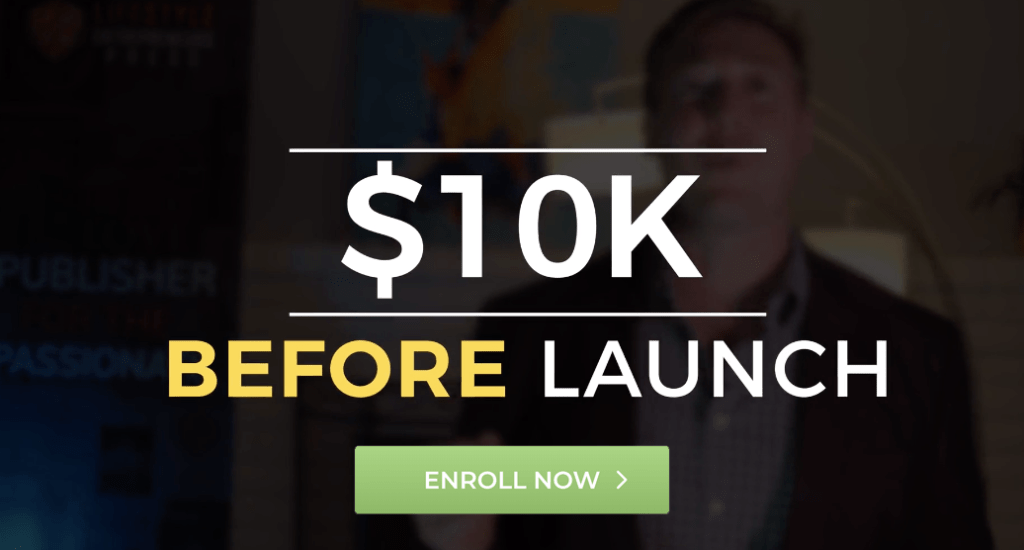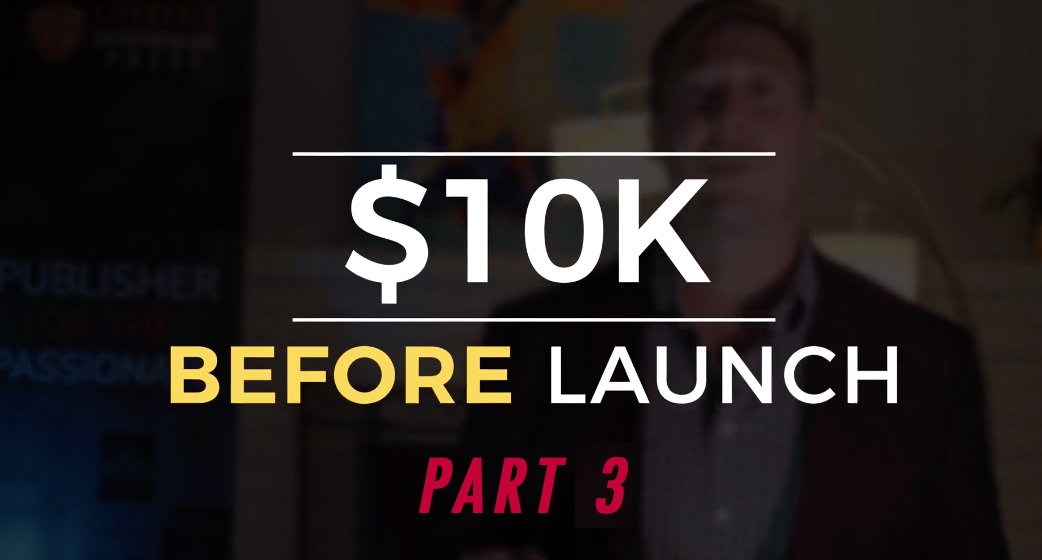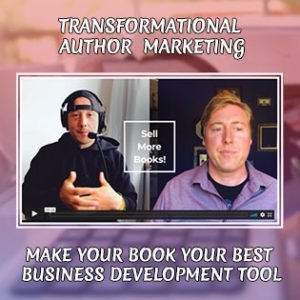How to Avoid Book Launch Mistakes to Save You Time, Money and Soul-Crushing Frustration
In this training we’re going to talk about how to avoid the biggest mistakes of launching that will save you months of time, energy, and money. And so when it comes to launching both a book, a product, a program, whatever offer that you have, the biggest mistakes that people make are not telling anybody about it, creating it in a vacuum and really just not giving the sales effort and the marketing effort, the attention that they deserve. Rather they focus all of their energy and effort on creating the thing itself, writing the book itself, creating the product, designing a whole website or all of the collateral that’s, that’s needed to bring one of these offers to market without having a feedback loop or a dialogue with anybody that would be a potential customer. One of the best ways to avoid that as your reality is by engaging with people early and often and pinging, giving little taste tests, telling people that you’re working on something, bringing the excitement and enthusiasm that you must already have to have written a book and to be going into business and creating new offers in a way that’s not salesy, but that’s actually enticing and that builds interest and intrigue.
Because the thing that I see time and time again, and I’ve made this mistake, in fact, I don’t really know anybody that’s become successful that hasn’t made this mistake, but maybe you’ll be one of the first, because you’re in this course and you’re watching this and you’re learning, do the entire creation process before the marketing, the sales process, and I’m just gonna hammer this in because it’s really at the heart of everything that we’re talking about here, that before you actually create something, you should create the language that describes it. You should create the marketing points. You should create the value and the benefits that your customers or readers will get. Because when you’re clear on that, then you have the language to communicate what it is that people are going to learn from engaging with you either through your book or some aspect of your business and brand.
And so if you start to think about how would you describe your book in one sentence that doesn’t talk about the framework, that doesn’t talk about your personal story, that only focuses on what the reader’s going to get out of it, then you’re starting to move in the right direction. And so we’re going to look at some examples here on the screen of different sales points for books, different descriptions, or we can call them a key selling point, if you will, that starts to share the language that’s used to get people excited about your book. And then we’re going to do the same with the different products and business offerings that you have. So let’s take a look at that now. All right, welcome back. I hope that was helpful. Looking at some key selling points for books and help you start to think of the language that you’ll use to describe your book to somebody that doesn’t already know the whole story that hasn’t been following your journey or that doesn’t even necessarily know that you’re writing a book.
We’re talking about using benefit driven language that speaks to what the reader is going to learn and the same concept applies to your other offers. In fact, all of them. And so what we’re getting into here is first figuring out how you’re going to describe the product, the program, the experience, the service that you’re making available in a way that somebody says, yes, I’m interested, I want to learn more, I want to sign up, how do I pay? And then from there you move into the actual creation and delivery. And again, this is something that if you’re hearing it for the first time, it’s worth saying it over and over again until you really get it. Because one of the biggest mistakes you can make, and it’s an expensive mistake and it’s time consuming. And that’s the one thing we can’t get back is to spend all the energy and the resources to create something and then do what I call like the Spiderman approach where it just pops out of nowhere and it’s right in front of your face and you’re like, ah, what’s that?
People need to be warmed up. They need to be clear on the value that they’re going to get from your offer at the time that they make the decision to buy it and at the time that they make the decision to buy it, they haven’t seen or experienced what it actually is. So let’s look at this for a little bit. Like if I was to offer a coaching program, let’s say it would be, and this is something that you can start to model for yourself. If I was going to offer a three month coaching program to teach you how to launch your book and become a number one bestseller, then the first things I do would be to describe to you how you’re going to accomplish that goal and what you’re going to learn. So I would talk about it in a way of saying, do you want to understand how in the next three months you can launch your book and become a number one bestseller?
Even if you don’t have an audience and you haven’t published a book before, that starts to become a benefit driven statement that doesn’t speak to all of the specifics that you’re going to learn in that course. Or you could say something to the effect of how great would it feel when your book comes out and on the first day you’ve got 10 if not dozens of five star reviews from people that are already excited because they’ve gotten your book and they like what they’ve read and now their chance to leave a review is finally here, right? That’s another example of how you can start to pre-sell the benefits of what people are going to get without actually telling them the step by step process of what they’re going to learn. And this whole discussion of features versus benefits is really integral to becoming a good marketer.
And if you cringe at hearing marketing, then don’t just start to get familiar with speaking in benefit driven language and think of marketing as education that leads to an action and then it becomes much more fun. You’re really educating people and showing them what’s possible and then showing them the next step that they can take to get that outcome and to get that benefit. Well, the way to do that is to purchase, fill in the blank with whatever your product, your program, your offer actually is. And so what I want you to start doing is think about any product or program that you want to roll out and think about one to three sentences that describes it in terms of what that customer, what the participant is going to get out of it. When you get into this process and you do this right, then when you actually build and deliver and fulfill on those purchases, those offers, you’re doing it one with people that have already invested.
So there’s a little bit more excitement and enthusiasm to deliver something to people that have already paid as opposed to building something and then hoping somebody wants to buy it. But also it creates an amazing accountability for you as the leader, as the entrepreneur, as the person that’s delivering this. Because I can tell you, speaking from experience, anytime somebody paid me well, what people pay for, they’re paying attention to and where people pay me for is who I’m paying attention to, right? And if your focus is on delivering value to people that have invested with you, whether that’s at a lower level and buying your book or the highest level of let’s say a five figure high ticket offer. In either case, when people invest and they pull out their wallet and make that purchase, then it creates a bond that is valuable and integral to building a business.
Now what you do with it is the next step, right? Once you create that bond and you create a customer, that’s amazing. And that’s step one. And that’s more than most people accomplish before creating and rolling something out. But that just think about how that creates both additional in attention from the customer to you as well as accountability from you, the customer, right? Anytime somebody paid me or purchased a product or program or anything that I’ve offered that has a price tag on it, those are the people that I’m focusing on giving the best experience possible. And in fact, that’s when I really engage my time and energy and resources to make that happen, right? I want to achieve and overachieve on the expectations of people that have made a purchase. And if you get into that mindset, then it becomes more exciting to get the purchase and make the sale knowing that now people have paid so they’re paying attention and now you’ve been paid.
So you have the accountability to deliver and you know the timeframe within which you’re going to do so. And so when we look at how to avoid the biggest mistakes of launching, that will save you months of time, energy, and resources. It comes down to this creating the benefit driven language that’s going to let your potential readers let your potential customers and clients know what they’re going to get out of this transaction, out of this value exchange of money for service, money for product. And it’s also about testing the market, right? Making sure that you don’t miss the market by offering something. And if there’s no interest and you haven’t created it yet, well then you never do have to create it. So as we’re going to go deeper into this, we’re going to create and you’re going to create three different offers that you can feature in your prelaunch campaign.
And maybe only one of them really blows it out of the water. Well, that’s great because now you just saved yourself the time, energy, and money and frustration of creating the two other offers that just didn’t really land. So when you pre-sell and you’ve got the options for people to engage in a few different ways as a customer, as a paying client, then that determines where you allocate your energy and effort to delivering and fulfilling on that experience in a compelling, sincere way. There’s no shortcut to delivering a great experience and value to your customer, but there’s a huge shortcut to becoming frustrated and potentially even going broke by spending all of your time creating something without any time thinking about how you’re going to market and sell it. So that’s really at the crux of how to avoid the biggest mistakes in launching. And I hope that this has been valuable and useful to you in thinking about in shifting your mindset towards marketing and selling before creating, fulfilling and delivering.
Click Here to Access the Complete $10K Before Launch Training Program





Quite interesting stuff. Sounds like reverse engineering.